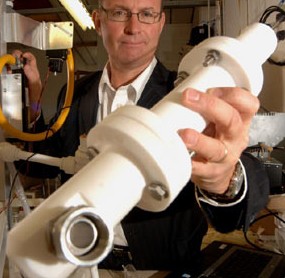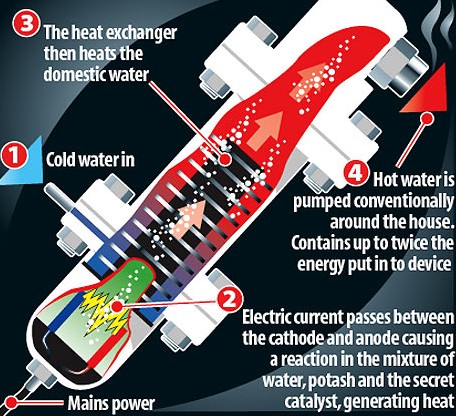|
Note their offical web site is no longer available!
www.ecowatts.co.uk
You will notice that the device has a COP>1 (co efficiency of performance greater then one) and this has been confirmed by independent university tests.
Panacea feels that following information is useful to assist the mainstream faculties in the understanding of the ELECTRICAL "COP" of the devices mentioned in this section.COP -Coefficient Of Performance.
The "COP" of greater then one occurs in most of devices listed here under our research and developmet principles.These devices are open systems and receive additional energy from the environment to produce excess ELECTRICAL energy.
The definition of COP is where is the output power of a device is divided by the input power which the USER has to put in to make it work. The COP of a bicycle is low because the user has to put in all the energy to make it work, overcome friction, overcome wind-pressure, overcome rolling resistance, etc.
The COP of a solar panel in sunlight, a windmill in wind, a waterwheel in a flowing river, is infinity as there is a power output and the energy input from the user needed to make it work is zero, and any number divided by zero is infinity.
A device with COP = 1 is a device where the power output is exactly the amount of input energy provided by the user - say, 100 watts of mechanical input power, producing 100 watts of electricity. Conventional science sees that as the almost impossible to achieve optimum, and it is.
With the Chris Eccles heater shown in the following article 100 watts of input electricity is producing 180 to 200 watts worth of heated water, so the COP is in the range of 1.8 to 2.0 and this has been confirmed by independent university testing. This proves that "free-energy" exists and can be had for the taking if you know how.
This analogy can also help the mainstream curricular's to "over unity". "over unity" is impossible. "Over unity" means more energy coming out of a system than is going into that system. This is impossible.
The difference here is that we are now talking about "efficiency" and it is a physical impossibility to have more than 100% of anything. If you spend 100% of the money you own, then that is it, it is all gone and there is no more. Common sense: if you have ten beers, the largest number of those beers that you can drink is ten - you can't drink eleven of them as the eleventh does not exist. In the same way, if 100 watts of power goes into a device, then the maximum power that can come out of that device is 100 watts.
So then, how is COP>1 possible? (This is the big problem for people who don't realise that the zero-point energy field exists). The answer lies in the definition of COP where the input power is taken as the power which WE put into the device.
Take the case of an electrical solar panel in sunlight. WE put no energy in, so the COP is infinity and we can put our feet up while we watch that panel charging our battery bank (and drink the last of our ten beers). But, that solar panel has a pathetic efficiency of some 17%, way, way below the 100% "unity" figure.
How come? Well, the input power is coming from the sunlight arriving from our environment. Only 17 watts out of every 100 watts of sunlight power landing on the solar panel is converted to electricity and comes out of the panel to charge our battery bank. This is very, very far below the impossible "over unity" efficiency (actually, 83.0001% below) and yet, because of our definition of the very useful "COP" value, the COP of the solar panel is so big that we can't write the number down, and have to just weakly describe it as "infinity".
Original article
How this 12inch miracle tube could halve heating bills. Amazing British invention creates MORE energy than you put into it - and could soon be warming your home -15th September 2007
It sounds too good to be true - not to mention the fact that it violates almost every known law of physics. But British scientists claim they have invented a revolutionary device that seems to 'create' energy from virtually nothing. Their so-called thermal energy cell could soon be fitted into ordinary homes, halving domestic heating bills and making a major contribution towards cutting carbon emissions.

Hot stuff: Ecowatts boss Paul Calver with the device
Even the makers of the device are at a loss to explain exactly how it works - but sceptical independent scientists carried out their own tests and discovered that the 12in x 2in tube really does produce far more heat energy than the electrical energy put in.The device seems to break the fundamental physical law that energy cannot be created from nothing - but researchers believe it taps into a previously unrecognised source of energy, stored at a sub-atomic level within the hydrogen atoms in water.

The system - developed by scientists at a firm called Ecowatts in a nondescript laboratory on an industrial estate at Lancing, West Sussex - involves passing an electrical current through a mixture of water, potassium carbonate (otherwise known as potash) and a secret liquid catalyst, based on chrome. This creates a reaction that releases an incredible amount of energy compared to that put in. If the reaction takes place in a unit surrounded by water, the liquid heats up, which could form the basis for a household heating system.
If the technology can be developed on a domestic scale, it means consumers will need much less energy for heating and hot water - creating smaller bills and fewer greenhouse gases. Jim Lyons, of the University of York, independently evaluated the system. He said: 'Let's be honest, people are generally pretty sceptical about this kind of thing. Our team was happy to take on the evaluation, even if to prove it didn't work.'But this is a very efficient replacement for the traditional immersion heater. We have examined this interesting technology and when we got the rig operating, we were getting 150 to 200 per cent more energy out than we put in, without trying too hard.
People are sceptical - but somehow it works 'We are still not clear about the science involved here, because the physics and chemistry are very different-to everything that has gone before. Our challenge now is to study the science and how it works.' The device has taken ten years of painstaking work by a small team at Ecowatts' tiny red-brick laboratory, and bosses predict a household version of their device will be ready to go on sale within the next 18 months.
The project, which has cost the company £1.4million, has the backing of the Department of Trade and Industry, which is keen to help poorer families without traditional central heating or who cannot afford rocketing fuel bills.
Ecowatts says the device will cost between £1,500 and £2,000, in line with the price of traditional systems.The development of the groundbreaking technology results from a chance meeting between Ecowatts chairman Chris Davies, his wife Jane and an Irish inventor, Christopher Eccles, while the couple were on holiday near Shannon in 1998.
After the inventor showed the couple his laboratory experiments, Mrs Davies, immediately signed a £20,000 cheque on the bonnet of her car and handed it over to Mr Eccles. He later became chief scientist of Ecowatts' parent company Gardner Watts, but has since left after 'falling out' with the company, according to insiders. Sadly, Mrs Davies died three years ago, so she will be unable to share in the success of her husband's development of the idea.
Mr Davies, now 75, of Dedham, Essex, was unavailable for comment last night. But Ecowatts chief executive Paul Calver said: 'When Jane Davies whipped out her cheque book, it turned out to be a very good investment indeed. 'She and Chris were always interested in ecology and now it looks as if our heat exchanger system is ready to go on sale soon. We're producing a device in the next nine months to heat radiators.
'Most British homes rely on gas, and the Government has admitted there is a problem getting a substitute. Our device will help solve that.' Sustainable energy expert Professor Saffa Riffat, of Nottingham University, has also led a team investigating the system. He said: 'The concept is very interesting and it could be a major breakthrough, but more tests are required. We will be doing further checks.
Link
Research Links
Directory:Ecowatts_Thermal_Energy_Cell
Next is the Roto Verter Technology
|